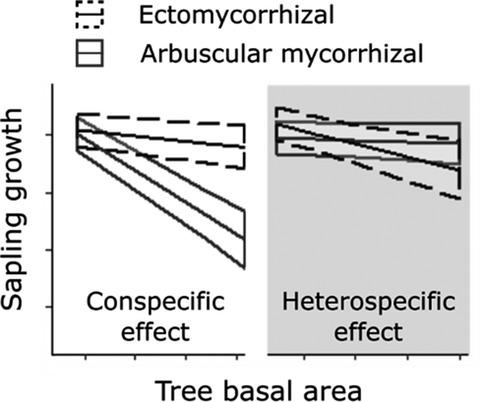Our official English website, www.x-mol.net, welcomes your feedback! (Note: you will need to create a separate account there.)
Shade tolerance and mycorrhizal type may influence sapling susceptibility to conspecific negative density dependence
Journal of Ecology ( IF 5.5 ) Pub Date : 2019-07-23 , DOI: 10.1111/1365-2745.13237 Alissa J. Brown 1 , Christopher J. Payne 2 , Peter S. White 1, 2 , Robert K. Peet 1, 2
中文翻译:

遮荫耐受性和菌根类型可能会影响幼树对特定负密度依赖的敏感性
更新日期:2019-07-23
Journal of Ecology ( IF 5.5 ) Pub Date : 2019-07-23 , DOI: 10.1111/1365-2745.13237 Alissa J. Brown 1 , Christopher J. Payne 2 , Peter S. White 1, 2 , Robert K. Peet 1, 2
Affiliation

|
- The maintenance of tree diversity has been explained by multiple mechanisms. One of the most thoroughly studied is conspecific negative density dependence, in which specialist plant enemies reduce survivorship of seeds, seedlings or saplings located near adult conspecifics. Although there is much support that conspecific negative density dependence occurs in temperate forests, only a subset of the species investigated thus far exhibit this recruitment pattern. It remains unclear what drives differential susceptibility to conspecifics among tree species. Previous investigators have considered shade tolerance and mycorrhizal type (arbuscular mycorrhizal vs. ectomycorrhizal association) as two traits that might explain differential susceptibility to conspecific negative density dependence.
- Here, we test whether these two plant traits predict susceptibility of tree saplings to conspecific negative density dependence in a temperate hardwood forest using three responses: spatial point patterns of saplings, sapling growth and sapling survival.
- Spatial patterns of saplings indicate that shade tolerant species are less sensitive to conspecifics than shade intolerant species, but show no differences based on mycorrhizal type. Conversely, shade tolerant saplings exhibit reduced growth, but not survival, when located in areas with high conspecific density. We interpret this finding in light of the conservative functional strategies of shade tolerant species, which typically have low leaf nitrogen levels and slower growth to divert resources to tissue defence against enemies. We found an effect of mycorrhizal type interacting with adult conspecific density, where arbuscular mycorrhizal species show a greater reduction in growth than ectomycorrhizal species in areas dense with conspecifics.
- Synthesis. We conclude that the shade tolerance level and the mycorrhizal type of temperate forest saplings may influence how their growth and survival respond to the adult conspecific trees in their neighbourhoods.
中文翻译:

遮荫耐受性和菌根类型可能会影响幼树对特定负密度依赖的敏感性
- 树木多样性的维持已通过多种机制进行了解释。研究最透彻的问题之一是同种负密度依赖性,在这种依赖性下,专业植物敌人降低了成年同种雌性附近的种子,幼苗或树苗的存活率。尽管有很多证据表明在温带森林中存在特定的负密度依赖性,但迄今为止,只有一小部分物种表现出这种募集模式。尚不清楚是什么导致树木种间对种属的敏感性不同。以前的研究者已经将阴影耐受性和菌根类型(丛枝菌根与外生菌根的关联)视为两个特征,可以解释对特定负密度依赖的敏感性。
- 在这里,我们使用以下三个响应来测试这两种植物性状是否预测树苗对温带硬木森林中特定负密度依赖性的敏感性:树苗的空间点模式,树苗生长和树苗存活。
- 幼树的空间格局表明,耐荫物种比耐荫物种对同种物种的敏感度低,但根据菌根类型无差异。相反,当位于高同种密度的地区时,耐荫的树苗显示出生长减少,但没有存活。我们根据耐荫树种的保守功能策略来解释这一发现,这些树荫通常具有较低的叶氮水平和较慢的生长速度,从而将资源转移到组织中以防御敌人。我们发现了菌根类型与成年同种密度相互作用的影响,在同种异体密集的区域中,丛枝菌根种类比外生菌根种类表现出更大的减少。
- 综合。我们得出的结论是,温带森林树苗的耐荫性水平和菌根类型可能会影响其生长和存活对附近成年同种树的反应。



























 京公网安备 11010802027423号
京公网安备 11010802027423号